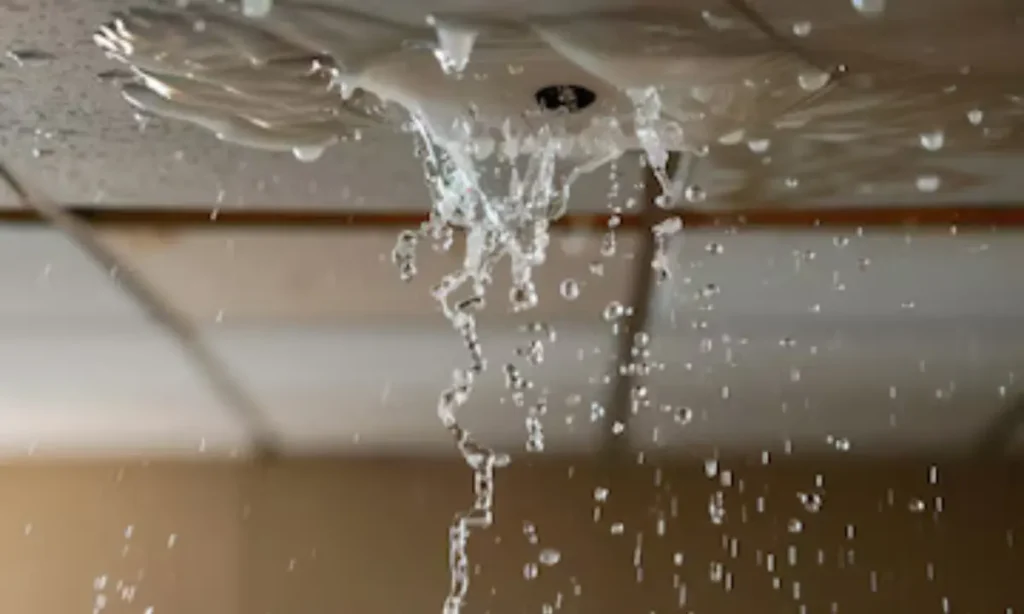The presence of water leaking from the ceilings creates both distressing and frustrating conditions. You must address the issue right away when water drips or you discover wet and spongy areas on your ceiling. The problem will transform into a danger for living if you ignore it.
A ceiling leak emerges because your plumbing system or roof needs immediate inspection. The identification of water sources remains critical to stop damage to your home structure. The article describes how to handle ceiling water leaks and provides methods to prevent their deterioration.
How to Find the Source of a Leak in the Ceiling

Identifying ceiling leaks at their initial stage helps prevent future repair expenses. Water marks, together with sagging areas and peeling paint, and musty odors, indicate that leaks exist. Act immediately after detecting any of these signs. Here are the easy steps you can take to find where a leak is coming from in a ceiling.
- Note the Leak Area: Examine the water flow from above to identify the leaking area before marking it with a pencil. A moisture detector should be used to check areas that are not visible.
- Look for Collection Points: Examine light fixtures along with kitchen wall cabinets since they tend to accumulate water.
- Inspect the Area Above the Leak: When a leak occurs under the attic, you should examine the insulation. Check the underside for signs of moisture when a leak occurs below a roof. Check plumbing components such as toilets, showers, and bathtubs when the leak is found beneath the floor.
- Check Gutters: Inspect gutters for debris. Water can flow into the attic through overflowing gutters.
- Investigate the Roof: Check for missing or damaged shingles, especially at the edges or near the chimney. Look for any leaks in check flashing, pipes, and vents.
How to fix water leakage in a ceiling?

Water leaks through ceilings for several reasons. Early identifying the cause can stop further damage. Some of the common causes of ceiling leaks are damaged pipes, bathroom fixtures, clogged gutters and roof issues. Here how to fix these causes:
Damaged Pipes
Damaged pipes are the most common cause of ceiling leak. Pipes can rust, crack, or wear out over time and water can escape. Frozen pipes in cold weather can also burst and leak. Pressure can also build up in clogged pipes and cause cracks and leaks. Accidentally, renovations may damage pipes and cause leaks in the ceiling.
How to Fix
- Replace the water supply line to the toilet if it’s leaking.
- Run water and check the P-trap under the sink for leaks. Reinstall or replace if necessary.
- Tighten or replace any leaking water supply lines under the bathroom sink.
- Cut away drywall and replace leaking pipes with PEX plastic pipes or copper lines.
Leaking Shower or Bathtub
Bathroom fixtures create conditions that lead to bathroom ceiling leakage. The combination of damaged pipes, leaking drains and overflowing bathtubs and deteriorated seals leads to ceiling leaks. Water from showers or bathtubs has the potential to leak from various areas including the faucet and drain and overflow.
How to Fix
- Replace or fix any leaking shower doors.
- Apply caulk between the bathroom floor and bathtub or shower pan.
- Unscrew the shower head, apply Teflon tape, and reattach.
- Replace the drain’s plumber’s putty and tighten it.
- Check and reseal the overflow drain in the bathtub.
Overflowing Gutters

Leak occurs along the outer wall where the gutters meet the house. Leaking gutters can cause leaks in your ceiling, and clogged or damaged gutters can cause the same. Water from overflowing gutters can flow into the walls and the moisture seeps through the ceiling.
How to Fix
- Clean out leaves and debris from gutters and downspouts.
- Re-screw sagging sections or replace them.
- Install screens to prevent debris buildup in gutters.
Damaged Roof
Another frequent cause of ceiling leaks is a damaged roof. The ceiling can be damaged by storms, tree debris or rain water. The roof repairs should be handled by professionals to avoid the problem from recurring.
How to Fix
- Clean out leaves and debris from gutters and downspouts.
- Re-screw sagging sections or replace them.
- Install screens to prevent debris buildup in gutters.
- Replace any bent or missing flashing.
- Consult a professional if you need to replace all of it.
Green Water & Fire, trust us if you need expert help with water damage!
Conclusion
Any ceiling water leakage requires immediate attention. Any water leakage requires immediate attention because it shows a serious issue regardless of its source such as broken pipes or leaking roofs or clogged gutters. The protection of your home depends on fast detection and immediate repair of its source. Identify water stains, peeling paint and sagging ceiling as warning signs to respond immediately.
FAQs:
Set a bucket or trash can, or a container, beneath the leak to collect the dripping water. You should attempt to catch the leak both from above in the attic, if possible.
Yes, A ceiling drip diverter provides a solution for safely diverting water away from ceilings. This tarp solution has a hose attachment that guides water safely beyond the ceiling area.
You should cut out and eliminate all wet drywall from the area. The drying process should be completed for all materials (wood and insulation, and subfloor) before installing new drywall.


















